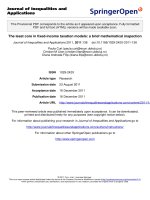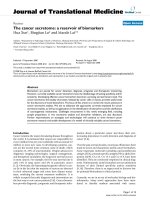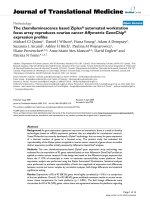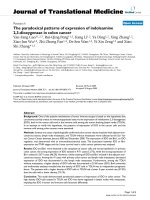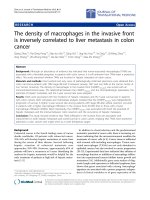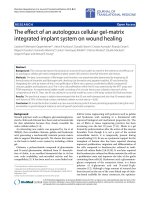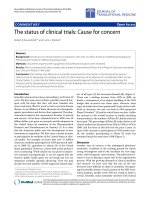báo cáo hóa học: " The Cervical Dystonia Impact Profile (CDIP-58): Can a Rasch developed patient reported outcome measure satisfy traditional psychometric criteria?" pptx
Bạn đang xem bản rút gọn của tài liệu. Xem và tải ngay bản đầy đủ của tài liệu tại đây (317.66 KB, 9 trang )
BioMed Central
Page 1 of 9
(page number not for citation purposes)
Health and Quality of Life Outcomes
Open Access
Research
The Cervical Dystonia Impact Profile (CDIP-58): Can a Rasch
developed patient reported outcome measure satisfy traditional
psychometric criteria?
Stefan J Cano
1,2
, Thomas T Warner
3
, Alan J Thompson
1
, Kailash P Bhatia
4
,
Ray Fitzpatrick
5
and Jeremy C Hobart*
2,1
Address:
1
Neurological Outcome Measures Unit, Institute of Neurology, University College London, Queen Square, London, UK,
2
Department of
Clinical Neuroscience, Room N16 ITTC Building, Peninsula College of Medicine and Dentistry, Tamar Science Park, Davy Road, Plymouth, UK,
3
Department of Clinical Neurosciences Royal Free & University College Medical School, London, UK,
4
Sobell Department of Motor Neuroscience
and Movement Disorders, Institute of Neurology, University College London, Queen Square, London, UK and
5
Department of Public Health,
University of Oxford, Old Road Campus, Roosevelt Drive, Headington, Oxford, UK
Email: Stefan J Cano - ; Thomas T Warner - ; Alan J Thompson - ;
Kailash P Bhatia - ; Ray Fitzpatrick - ;
Jeremy C Hobart* -
* Corresponding author
Abstract
Background: The United States Food and Drug Administration (FDA) are currently producing
guidelines for the scientific adequacy of patient reported outcome measures (PROMs) in clinical
trials, which will have implications for the selection of scales used in future clinical trials. In this
study, we examine how the Cervical Dystonia Impact Profile (CDIP-58), a rigorous Rasch
measurement developed neurologic PROM, stands up to traditional psychometric criteria for three
reasons: 1) provide traditional psychometric evidence for the CDIP-58 in line with proposed FDA
guidelines; 2) enable researchers and clinicians to compare it with existing dystonia PROMs; and 3)
help researchers and clinicians bridge the knowledge gap between old and new methods of
reliability and validity testing.
Methods: We evaluated traditional psychometric properties of data quality, scaling assumptions,
targeting, reliability and validity in a group of 391 people with CD. The main outcome measures
used were the CDIP-58, Medical Outcome Study Short Form-36, the 28-item General Health
Questionnaire, and Hospital and Anxiety and Depression Scale.
Results: A total of 391 people returned completed questionnaires (corrected response rate 87%).
Analyses showed: 1) data quality was high (low missing data ≤ 4%, subscale scores could be
computed for > 96% of the sample); 2) item groupings passed tests for scaling assumptions; 3) good
targeting (except for the Sleep subscale, ceiling effect = 27%); 4) good reliability (Cronbach's alpha
≥ 0.92, test-retest intraclass correlations ≥ 0.83); and 5) validity was supported.
Conclusion: This study has shown that new psychometric methods can produce a PROM that
stands up to traditional criteria and supports the clinical advantages of Rasch analysis.
Published: 6 August 2008
Health and Quality of Life Outcomes 2008, 6:58 doi:10.1186/1477-7525-6-58
Received: 8 December 2007
Accepted: 6 August 2008
This article is available from: />© 2008 Cano et al; licensee BioMed Central Ltd.
This is an Open Access article distributed under the terms of the Creative Commons Attribution License ( />),
which permits unrestricted use, distribution, and reproduction in any medium, provided the original work is properly cited.
Health and Quality of Life Outcomes 2008, 6:58 />Page 2 of 9
(page number not for citation purposes)
Background
Patient reported outcome measures (PROMs) are increas-
ingly being used as primary or secondary outcome meas-
ures in clinical trials [1,2]. As such, the quality of
inferences made from clinical trials is dependent on the
PROMs used. This increasingly acknowledged fact has led
the United States Food and Drug Administration (FDA) to
produce guidelines [3,4] that specify minimum criteria for
the scientific adequacy of scales in clinical trials. These are
likely to be followed by the European Medicines Agency
(EMEA) [5], and will have implications for all scales used
in future clinical trials.
The Cervical Dystonia Impact Profile (CDIP-58) assesses
the health impact of CD [6]. It was developed using new,
sophisticated, but not widely known techniques of
PROMs construction (Rasch analysis), which are, as of yet,
not included in the FDA guidelines. In addition, research-
ers interested in using the CDIP-58, who may be unfamil-
iar with new psychometric methods, may find the original
paper [6] abstruse and intangible.
The aim of this study is to provide clinicians with a com-
prehensive evaluation of the CDIP-58 using a traditional
approach to scale evaluation for three reasons: 1) provide
traditional psychometric evidence for the CDIP-58 in line
with the proposed FDA guidelines; 2) enable researchers
and clinicians to make their own judgment of its perform-
ance and compare it with existing dystonia scales; and 3)
help researchers and clinicians bridge the knowledge gap
between old and new reliability and validity testing meth-
ods.
Methods
Setting and Participants
A random sample of 460 people with CD was recruited
from a complete list of 1110 members from the Dystonia
Society of Great Britain. The sampling strategy is described
elsewhere [6]. A booklet of questionnaires was adminis-
tered as a postal survey following standard techniques [7].
In addition, 140 individuals were randomly selected to
receive a second identical battery after 2 weeks to estimate
test-retest reproducibility (TRT). This study was reviewed
and passed by the local hospital trust research ethics com-
mittee.
Measurement model
In the traditional psychometric paradigm, a measurement
model proposes how items in a measure are grouped into
scales, and in turn how scales are scored. This definition
of a measurement model is different to that in the Rasch
measurement paradigm, which instead views it as a for-
mulation that represents the structure which data should
exhibit in order to obtain measurements from the data.
The CDIP-58 measurement model groups the 58 items
into eight subscales: head and neck symptoms (6 items),
pain and discomfort (5 items), upper limb activities (9
items), walking (9 items), sleep (4 items), annoyance (8
items), mood (7 items), and psychosocial functioning (10
items) [6]. We examined whether the model (Figure 1)
fulfilled fundamental prerequisites for rigorous measure-
ment as defined by traditional psychometric approaches
[8,9].
Data analyses
CDIP-58 subscale item responses were summed without
weighting or standardisation to generate scores [10]. Each
subscale score was transformed to have a common range
of 0 (no impact) to 100 (most impact) [11]. Five psycho-
metric properties were examined: data quality, scaling
assumptions, targeting, reliability and validity. Table 1
shows the extent to which the CDIP-58 testing conforms
to the draft guidelines proposed by the FDA [3,4].
Data quality
Data quality concerns the completeness of item- and
scale-level data, and was determined by the percentage of
missing data for items, and the percentage of computable
scale scores [8]. The criterion for acceptable item-level
missing data was < 10% [12] and for computable scale
scores > 50% completed items [13].
Scaling assumptions
Three scaling assumptions should be satisfied for scale
scores to be generated using the proposed item groups,
and Likert's method of summated ratings [14,15].
1. Items in each scale should measure a common underly-
ing construct otherwise it is not appropriate to combine
them to generate a scale score [16]. This was evaluated by
examining the correlation between each item and scale
score computed from the remaining items in that scale
(corrected item-total correlation). The criterion used was
corrected item-total correlation ≥ 0.30 [17].
2. Items in each scale should contain a similar proportion
of information concerning the construct being measured
otherwise they should be given different weights [10].
This criterion was determined by examining the equiva-
lence of corrected item-total correlations. The criterion
used was corrected item-total correlation ≥ 0.30 [17].
3. Items should be correctly grouped into scales. That is,
items should correlate higher with the total score of their
own scales (item own-scale correlation) than with the
total score of the other scales (item other-scale correla-
tions). The recommended criterion for definite scaling
successes are item-own scale correlations (corrected for
overlap) exceeding item-other scale correlations by at least
two standard errors (2 × 1√n) [17]. In situations where
Health and Quality of Life Outcomes 2008, 6:58 />Page 3 of 9
(page number not for citation purposes)
Measurement model of the CDIP-58Figure 1
Measurement model of the CDIP-58.
Health and Quality of Life Outcomes 2008, 6:58 />Page 4 of 9
(page number not for citation purposes)
this criterion was not reached, we examined the magni-
tude of differences between item-own and item-other
scale correlations. The greater the magnitude of differ-
ences between item-own scale and item other-scale corre-
lations, the greater the support for scaling success.
Targeting
The targeting of a scale to a sample indicates whether a
scale is acceptable as a measure for the sample. It is recom-
mended that: scale scores should span the entire scale
range; floor (proportion of the sample at the maximum
scale score) and ceiling (proportion of the sample at the
minimum scale score) effects should be low (<15%) [18];
and skewness statistics ranging should range from -1 to +1
[19].
Reliability
Reliability is the extent to which scale scores are dependa-
ble and consistent. Two types were examined. Internal
consistency, reported as Cronbach's alpha coefficients,
estimates the random error associated with scores from
the intercorrelations among the items [20]. TRT reproduc-
ibility, reported as intraclass correlations coefficients
(ICC) on scores produced by a sub sample assessed twice
over a 2-week interval, estimates the ability of CDIP-58
subscales to produce stable scores over a given period of
time in which the respondents' condition is assumed to
have remained the same [19]. We used a two-way random
effects model based on absolute agreement as a suitable,
conservative estimate of test retest reliability, as this type
of ICC accounts for the systematic differences among lev-
els of ratings. This is because the raters used were only a
sample of all possible raters. We used a two-way random
effects model based on absolute agreement as a suitable
conservative estimate test retest reliability, as this type of
ICC accounts for the systematic differences among levels
of ratings [21]. Recommended criteria for adequate relia-
bility are Cronbach's alpha coefficient ≥ 0.80 [21], and
TRT ICC ≥ 0.80 [22].
Validity
Validity is the extent to which a scale measures what it
intends to measure and is essential for the accurate and
meaningful interpretation of scores [23]. Three aspects
were tested:
1. Intercorrelations between CDIP-58 subscales were
assessed to examine the extent to which scales measured
Table 1: Adapted from table 4 of the FDA draft guidelines for measurement properties reviewed for PRO instruments used in clinical
trials
Measurement Property Test Methods used in testing the CDIP-58
Reliability Test-retest 3
Internal consistency Whether the items in a domain are intercorrelated,
as evidenced by an internal consistency statistic
(e.g., coefficient alpha)
3
Inter-interviewer reproducibility
(for interviewer-administered PROs only)
Agreement between responses when the PRO is
administered by two or more different interviewers
NA
Validity Content-related 3*
Ability to measure the concept (also known as
construct-related validity; can include tests for
discriminant, convergent, and known-groups
validity)
Whether relationships among items, domains, and
concepts conform to what is predicted by the
conceptual framework for the PRO instrument
itself and its validation hypotheses.
3
Ability to predict future outcomes
(also known as predictive validity)
Whether future events or status can be predicted
by changes in the PRO scores
7
Ability to detect change Includes calculations of effect size and standard
error of measurement among others
3**
Interpretability Smallest difference that is considered clinically
important; this can be a specified difference (the
minimum important difference (MID)) or, in some
cases, any detectable difference. The MID is used as
a benchmark to interpret mean score differences
between treatment arms in a clinical trial
3/7***
Responder definition – used to identify
responders in clinical trials for analyzing
differences in the proportion of responders
between treatment arms
Change in score that would be clear evidence that
an individual patient experienced a treatment
benefit. Can be based on experience with the
measure using a distribution-based approach, a
clinical or non-clinical anchor, an empirical rule, or a
combination of approaches.
NA
3 = tested; 7 = not tested; * Reported in Cano et al 2004 [6]; ** Reported in Cano et al 2006 [28]; *** Although not including MID in our
responsiveness paper (Cano et al, 2006 [28]), we include a comparison of relative responsiveness to existing PROs used in CD research in order to
increase the interpretability of CDIP-58 change scores against these measures.
Health and Quality of Life Outcomes 2008, 6:58 />Page 5 of 9
(page number not for citation purposes)
separate but related constructs [8]. The magnitude of
intercorrelations between CDIP-58 subscale scores were
predicted to be consistent with expectation about the
proximity of the constructs, and were generally expected
to be moderate in size (r = 0.30–0.70) [24]. In addition,
subscale reliabilities should be larger that inter-scale cor-
relations to support that scales measure distinct con-
structs.
2. Correlations between CDIP-58 subscales and other
scales were examined. Patients were asked to complete
three other questionnaires for validity testing: Medical
Outcome Study 36-item Short Form Health Survey (SF-
36) measures health status in eight multi-item scales
(Role Limitations-Emotional, Role Limitations-Physical,
Bodily Pain, Vitality, General Health Perceptions, Social
Functioning, Physical Functioning, Mental Health) [25];
28-item version of the General Health Questionnaire
(GHQ-28) measures psychological well being in four
dimensions (Somatic Symptoms, Anxiety, Social, Depres-
sion) [26], and Hospital and Anxiety and Depression
Scale (HADS) measures mood in two scales (Depression
and Anxiety) [27]. A number of hypotheses were made
based on the direction, magnitude and pattern of correla-
tions being consistent with expectations based on the
proximity of the constructs.
Ideally for the results of correlations between CDIP-58
subscales and other scales to be fully interpretable the
external measures should be reliable and valid. Whereas
we have previously examined the psychometric properties
of the SF-36 in CD [9], there are no current published arti-
cles which have examined the HADS or GHQ-28. Our rea-
soning for selecting the latter two scales was on the basis
of their wide-spread use in neurologic research. Impor-
tantly, this is a common limitation of reliability and valid-
ity testing and the findings should be interpreted with this
borne in mind.
Criteria were used as guides as to the magnitude of corre-
lations, as opposed to pass/fail benchmarks (high correla-
tion r > 0.70 and moderate correlation r = 0.30–0.70):
a. The Pain and Discomfort subscale would correlate more
highly with the SF-36 bodily pain than with unrelated
measures of psychological functioning (SF-36 Mental
Health, HADS Anxiety and Depression).
b. The Upper Limb and Walking subscales would correlate
more highly with the SF-36 physical functioning than
with unrelated measures of psychological functioning
(SF-36 Mental Health, HADS Anxiety and Depression,
GHQ-28).
c. The Annoyance and Mood subscales would correlate
more highly with the SF-36 Mental Health than with unre-
lated measures of physical functioning (e.g. SF-36 physi-
cal functioning).
d. The Annoyance and Mood subscales would correlate
moderately with the HADS, GHQ-28 anxiety and depres-
sion scales as these reflect aspects of mood.
e. The Psychosocial Functioning subscale would correlate
moderately with the SF-36 social functioning as this
reflects an aspect of psychosocial functioning.
3. Correlations between CDIP-58 subscales and sociode-
mographic variables (age, sex, and level of education
attained) were examined to determine the extent to which
they were biased by these variables. We predicted that
these correlations would be low < 0.30.
Results
Sample
Of the 460 patients who received the CDIP-58, 391
returned completed questionnaires (corrected response
rate = 87%). Of the 140 TRT questionnaires, 105 were
returned completed (corrected response rate = 75%). The
sample included people with a wide range of ages and dis-
ease duration (Table 2) [6].
Psychometric properties
Data quality (Table 3)
Data quality was high. The proportion of item-level miss-
ing data was low (≤ 4%). Subscale scores could be com-
puted for at least 96% of the sample.
Scaling assumptions (Table 3)
Item groupings in each of the eight CDIP-58 subscales
passed tests for scaling assumptions:
1. Corrected item-total correlations for each of the eight
CDIP subscales ranged from 0.64–0.93 satisfying the rec-
ommended criteria (> 0.30). This supported that items in
each subscale of the CDIP-58 measured a common under-
lying construct.
2. Corrected item-total correlations > 0.30 indicated that
items in each of the subscales contained a similar propor-
tion of information.
3. Fifty-five of the fifty-eight items correlated higher with
their own subscale than other subscales. Forty-seven of
these exceeded the criterion (2 × 1√n). This provided
some support for the grouping of items in each of the
eight subscales. There was less support for three items
which correlated higher with other subscales: Head Neck
Health and Quality of Life Outcomes 2008, 6:58 />Page 6 of 9
(page number not for citation purposes)
symptoms 'stiffness in your neck' (Pain and Discomfort
subscale, r = 0.72), Pain and Discomfort 'tightness in your
neck' (Head and Neck symptoms subscale, r = 0.75), and
Upper Limb 'getting tired when doing demanding physi-
cal activities' (Walking subscale, r = 0.82).
Targeting (Table 3)
Subscale scores spanned the entire scale range. However,
the Walking scale fell just outside of the criterion (ceiling
effect = 17%) and the Sleep subscale was found to have a
more significant ceiling effect (27%). Despite this,
responses were not notably skewed (-0.23 to +0.82).
These findings indicate good scale-to-sample targeting,
thus supporting total and subscale scores as appropriate
for all patients representing the full spectrum of CD
impact.
Reliability (Table 3)
Cronbach's alpha, and test-retest ICCs for all eight CDIP-
58 subscales were high (> 0.83), supporting their reliabil-
ity.
Validity (Table 4)
1. Intercorrelations between CDIP-58 subscales ranged
from 0.44 – 0.84, suggesting the subscales measured
related but different constructs. A few of the correlations
fell outside of the predicted range of correlations, and
were highly correlated (highlighted in Table 2). However,
the correlations were not unreasonable given the proxim-
ity of the constructs in each of the subscales (see Figure 1)
and scale reliabilities were larger than inter-scale correla-
tions supporting that CDIP-58 subscales measure distinct
constructs.
2. Correlations between CDIP-58 subscales and hypothe-
sised related scales of the SF-36, GHQ and HADS were
consistent with predictions (highlighted in Table 4). This
provides support that the CDIP-58 subscales measure
what they intend to measure.
3. Correlations between CDIP-58 subscales and sociode-
mographic variables (age, sex, and level of education
attained) were in general low (-0.17 to +0.06). This find-
ing suggests that responses to the CDIP-58 were not
biased by socio-demographic factors.
Discussion
The forthcoming FDA guidelines make it increasingly
important for researchers and clinicians to be exposed to
the science behind PROMs. In this study, the CDIP-58 sat-
isfied traditional psychometric criteria for data quality,
scaling assumptions, targeting, reliability and validity. We
hope that this, together with our previous work on con-
ceptual model and scale development [6] and assessment
of the sensitivity to clinical change of the CDIP-58 follow-
ing Botulinum Toxin Type A (that found it to be superior
to existing CD PROMs [28]), provides an evidence-base
for its use in clinical trials, in line with the forthcoming
FDA guidelines. As such, the CDIP-58 offers an advance
on current PROMs. In addition, our findings are relevant
to practicing neurologists, who can use this information
to compare the CDIP-58 to existing published CD PROM
data, which will help to avoid an ad hoc approach which
may negatively impact upon rigorous measurement.
Three main issues arise from the findings. First, were there
any instances where traditional psychometric criteria were
not met and how should we interpret these? Second, how
can the information provided here be used and what do
traditional psychomteric analyses tell us? Third, what is
the added value of using Rasch analysis to develop
PROMs and in particular, what benefits are gained from
the required additional investment in skill level, retrain-
ing and software costs?
Traditional psychometric analyses detected one problem
not identified by Rasch analysis. Tests of scaling assump-
Table 2: Respondent characteristics
Variable* Sample
Number 391
Sex
Female 72
Age
Mean (SD) 58 (12)
Range 25–88
Ethnicity
White 97
Years since CD onset
Mean (SD) 15 (10)
Range 2 – 50
Employment status
Retired 35
Employed 29
Unable to work due to CD 20
Treatment
Botulinum Injections 90
Drug therapy 53
Alternative treatment 0
Surgery 0
External measures (Mean; SD)
SF-36** Bodily Pain 46 (26)
SF-36 Social Functioning 55 (31)
SF-36 Physical Functioning 57 (29)
SF-36 Mental Health 62 (20)
GHQ*** Anxiety 38 (19)
GHQ Depression 14 (19)
HADS*** Anxiety 43 (24)
HADS Depression 33 (19)
*All values are percentages unless specified otherwise; ** range 0-100,
*** converted to 0-100 (original range 0-21)
Health and Quality of Life Outcomes 2008, 6:58 />Page 7 of 9
(page number not for citation purposes)
tions were failed by 3 items ('stiffness in the neck', 'tight-
ness in the neck', 'upset'). This means that they correlated
similarly with their own subscales and other subscales
they were not intended to belong in. There are three rea-
sons why this may be the case. First, the subscales in ques-
tion were themselves highly correlated. Second, these
items may be non-specific indicators of their intended
construct. Third, any item can exist conceptually in more
than one scale. The clinical implications of this are prob-
ably minimal, as the constructs measured by the three
subscales in question are anchored by the other items,
which in turn performed well psychometrically.
So, how can the information provided here be used and
what do traditional psychomteric analyses tell us?
Researchers who are unfamiliar with Rasch analysis can
use the information presented here to compare the CDIP-
58 to existing published CD PROM data. The caveat is that
any inferences made from this paper alone are con-
strained by the sample and scale limitations inherent to
all studies that use traditional psychometric analyses.
These include three main points. First, total scores are
often analysed as if they were interval measures. However,
it has been widely demonstrated that they are not, and
therefore, they are not measuring consistently across the
range of the scale. Importantly, we do not know the extent
to which they are measuring inconsistently across the
scale. Second, traditional psychometric analyses rely
directly on the items and samples used to estimate them.
This means that item properties vary depending on the
sample and patient scores in turn depend on the set of
items taken. Thus, the reliability and validity estimates of
a measure may differ across different patient groups.
Third, it is recommended that total scores are only used
for group comparison studies and not individual patient
measurement, because the confidence intervals around
individual patient scores are so wide [18].
Our study suggests that Rasch analysis can produce a reli-
able and valid measure as defined by traditional criteria.
What then is the added value of using new psychometric
methods? First, when scales are successfully developed
using Rasch analysis it is possible to transform ordinal
level scale scores into interval level measurements [29-
31]. This improves the accuracy with which we can meas-
ure differences between people and clinical change. Sec-
ond, Rasch analysis enables estimates suitable for
individual person measurement. This can help directly
inform upon patient monitoring, management and treat-
ment for patients. Third, reliability and validity estimates
computed using Rasch analysis are much less sample
dependent than those derived from traditional methods.
In addition, Rasch measurement methods afford more
sophisticated analyses to test theoretically driven concepts
and therefore provide empirical evidence for properties
such as construct validity. This has important relevance
Table 3: Data quality, scaling assumptions, targeting, reliability and validity
CDIP Scale Head and
Neck
Symptoms
(6 items)
Pain and
Discomfort
(5 items)
Upper
Limb
Activities
(9 items)
Walking
(9 items)
Sleep
(4 items)
Annoyance
(8 items)
Mood
(7 items)
Psycho-
social
Functioning
(10 items)
Psychometric property
Data quality
Item missing data (range %) 1–2 3–4 2–4 3–4 2 2–4 2–4 1–2
Computable scale scores (%) 98 97 98 97 98 98 96 99
Corrected item-total correlations
Mean 0.76 0.82 0.78 0.87 0.89 0.83 0.78 0.82
Range 0.67–0.81 0.70–0.87 0.64–0.87 0.82–0.91 0.84–0.93 0.79–0.89 0.68–0.84 0.70–0.90
Item-other scale correlations
Range 0.37–0.72 0.40–0.75 0.43–0.72 0.42–0.75 0.39–0.52 0.42–0.73 0.39–0.82 0.38–0.69
Scaling successes (%) 83 80 100 100 100 100 86 100
Targeting
Mean score 57.6 53.8 42.9 37.1 33.3 37.9 29.7 49.2
Standard deviation 25.6 27.9 27.6 31.5 31.5 26.9 24.9 29.5
Score range 0–100 0–100 0–100 0–100 0–100 0–100 0–100 0–100
Floor/ceiling effect (%) 1/6 2/7 7/0 17/4 27/7 7/4 13/1 5/4
Skewness -0.23 -0.15 0.11 0.44 0.66 0.51 0.82 0.02
Reliability (n = 377–385)
Cronbach's alpha 0.92 0.93 0.94 0.97 0.96 0.96 0.95 0.96
TRT (ICC; n = 92–95) 0.85 0.83 0.94 0.95 0.86 0.83 0.85 0.89
Health and Quality of Life Outcomes 2008, 6:58 />Page 8 of 9
(page number not for citation purposes)
for the generalisability of PROM evaluations. These bene-
fits are further explored in other relevant articles and texts
[1,2,32-34].
We envisage that this article, in conjunction with our pre-
vious articles on the Rasch development of the CDIP [6]
and our recent review in Lancet Neurology [2] describing
traditional and new psychometric techniques, can be used
by researchers and clinicians to help bridge the knowledge
gap between traditional and modern reliability and valid-
ity testing methods. This study has shown that Rasch anal-
ysis methods can produce a PROM that stands up to
traditional psychometric criteria. A demonstration of this
nature is rare. It is much more common that scales devel-
oped using traditional methods to be tested post hoc using
new approaches [35]. Nevertheless, direct comparisons of
new and traditional psychometric methods of any nature
in the medical literature are sparse, and at best superficial
[36,37] In part, this may be due to the fact that these two
approaches cannot be compared easily as they use differ-
ent methods, produce different information, and apply
different criteria for success and failure. Both approaches
have their supporters and traditional psychometric meth-
ods remain the dominant paradigm. However, we believe
that state-of-the-art clinical trials and research would ben-
efit from the advantages offered by Rasch analysis.
Conclusion
This study has shown that new psychometric methods can
produce a PROM that stands up to traditional criteria and
supports the clinical advantages of Rasch analysis. In addi-
tion, the CDIP-58 satisfied traditional reliability and
validity criteria further supporting it as a clinically useful
measure for use in routine practice, audit and treatment
trials.
Competing interests
The authors declare that they have no competing interests.
Authors' contributions
SC collected, conducted, analysed and interpreted the
data and wrote the manuscript. JH conceived and
designed the study and contributed to the interpretation
of data and writing of the manuscript. TW, RF, KB and AT
Table 4: Convergent and discriminant construct validity of the CDIP-58
Instrument Scale/
Dimension/
Variable
Validity
(Correlation)
Head and
Neck
Symptoms
(6 items)
Pain and
Discomfort
(5 items)
Upper
Limb
Activities
(9 items)
Walking
(9 items)
Sleep
(4 items)
Annoyance
(8 items)
Mood
(7 items)
Psycho-
social
Funct-ioning
(10 items)
CDIP-58 Head and Neck Symptoms
Pain and Discomfort 0.72
a
-
Upper Limb Activities 0.64 0.53 -
Walking 0.63 0.65 0.79
a
-
Sleep 0.50 0.53 0.54 0.50 -
Annoyance 0.63 0.55 0.60 0.56 0.52 - -
Mood 0.52 0.48 0.54 0.53 0.49 0.84
a
-
Psychosocial Functioning 0.67 0.51 0.55 0.53 0.44 0.73
a
0.69 -
SF-36* Bodily Pain -0.60 -0.71
b
-0.72 -0.62 -0.59 -0.54 -0.51 -0.48
Social Functioning -0.56 -0.56 -0.70 -0.62 -0.55 -0.63 -0.59 -0.69
b
Physical Functioning -0.45 -0.57 -0.80
b
-0.78
b
-0.53 -0.43
b
-0.43
b
-0.45
Mental Health -0.43 -0.41
b
-0.72
b
-0.40
b
-0.43 -0.73
b
-0.78
b
-0.60
HADS Anxiety 0.34 0.39
b
0.31
b
0.28
b
0.31 0.54
b
0.66
b
0.48
Depression 0.41 0.45
b
0.52
b
0.51
b
0.42 0.59
b
0.60
b
0.50
GHQ** Anxiety 0.30 0.30
b
0.34
b
0.19
b
0.22 0.44
b
0.50
b
0.30
Depression 0.35 0.29
b
0.31
b
0.36
b
0.18 0.53
b
0.66
b
0.43
Demo-graphic Age -0.05 -0.03 -0.02 0.01 0.00 -0.04 -0.07 0.00
Variables Sex -0.04 -0.17 0.02 -0.07 0.00 0.06 0.04 0.02
Education -0.04 -0.05 -0.01 -0.07 -0.02 -0.03 -0.03 -0.08
*4/8 scales omitted from table as not applicable to analyses; **2/8 scales omitted from table as not applicable to analyses
a
Correlations falling outside of the predicted range;
b
Correlations consistent with predictions
Publish with BioMed Central and every
scientist can read your work free of charge
"BioMed Central will be the most significant development for
disseminating the results of biomedical research in our lifetime."
Sir Paul Nurse, Cancer Research UK
Your research papers will be:
available free of charge to the entire biomedical community
peer reviewed and published immediately upon acceptance
cited in PubMed and archived on PubMed Central
yours — you keep the copyright
Submit your manuscript here:
/>BioMedcentral
Health and Quality of Life Outcomes 2008, 6:58 />Page 9 of 9
(page number not for citation purposes)
were involved in guiding the study including design and
acquisition of data, and reviewing drafts of this manu-
script. All authors read and approved the final manu-
script.
Acknowledgements
We wish to thank the people with CD who participated in this study and
Mr Alan Leng and Ms Laura Camfield at the Dystonia Society of Great Brit-
ain for help with recruitment. This study was supported by a project grant
from the Wellcome Trust. During the writing of this paper Dr Hobart ben-
efited by being on secondment to the School of Education, Murdoch Uni-
versity, Perth, Western Australia, and was support by the Royal Society of
Medicine (Ellison-Cliffe Travelling Fellowship), the MS Society of Great Brit-
ain and Northern Ireland, and the NHS Technology Assessment Pro-
gramme (but the opinions expressed do not necessarily reflect those of the
executive).
References
1. Hobart JC: Rating scales for neurologists. Journal of Neurology,
Neurosurgery, and Psychiatry 2003, 74:iv22-iv26.
2. Hobart JC, Cano SJ, Zajicek JP, Thompson AJ: Rating scales as out-
come measures for clinical trials in neurology: problems,
solutions, and recommendations. Lancet Neurology 2007,
6:1094-1105.
3. Administration FD: Patient reported outcome measures: use in
medical product development to support labelling claims.
[ />].
4. Revicki DA: FDA draft guidance and health-outcomes
research. Lancet 2007, 369:540-542.
5. Agency EM: Reflection paper on the regulatory guidance for
the use of the health-related quality of life (HRQL) measures
in the evaluation of medicinal products. London, ; 2006.
6. Cano SJ, Warner TT, Linacre JM, Bhatia KP, Thompson AJ, Fitzpatrick
R, Hobart JC: Capturing the true burden of dystonia on
patients: the Cervical Dystonia Impact Profile (CDIP-58).
Neurology 2004, 63:1629-1633.
7. Dillman DA: Mail and telephone surveys: the total design
method. New York, Wiley; 1978.
8. McHorney CA, Ware JEJ, Lu JFR, Sherbourne CD: The MOS 36-
Item Short-Form Health Survey (SF-36): III. Tests of data
quality, scaling assumptions and reliability across diverse
patient groups. Medical Care 1994, 32:40-66.
9. Cano SJ, Thompson AJ, Fitzpatrick R, Bhatia K, Thompson AJ, Warner
TT, Hobart JC: Evidence-based guidelines for using the Short
Form 36 in cervical dystonia. Movement Disorders 2006,
22:122-127.
10. Likert RA: A technique for the measurement of attitudes.
Archives of Psychology 1932, 140:5-55.
11. Stewart AL, Ware JEJ: Measuring functioning and well-being:
the Medical Outcomes Study approach. Durham, North Caro-
lina, Duke University Press; 1992.
12. Group TWHOQOL: The World Health Organisation Quality
of Life Assessment (WHOQOL): development and general
psychometric properties. Social Science and Medicine 1998,
46:1569-1585.
13. Ware JEJ, Snow KK, Kosinski M, Gandek B: SF-36 Health Survey
manual and interpretation guide. Boston, Massachusetts, Nim-
rod Press; 1993.
14. Hays RD, Hayashi T: Beyond internal consistency reliability:
rationale and user's guide for Multi-Trait Analysis Program
on the microcomputer. Behavior Research Methods, Instruments, &
Computers 1990, 22:167-175.
15. DeVellis RF: Scale development: theory and applications. In
Applied social research methods Volume 26. London, Sage publications;
1991:121.
16. Guttman LA: Some necessary conditions for common-factor
analysis.
Psychometrika 1954, 19:149-161.
17. Ware JEJ, Harris WJ, Gandek B, Rogers BW, Reese PR: MAP-R for
windows: multitrait / multi-item analysis program - revised
user's guide. Boston, MA, Health Assessment Lab.; 1997.
18. McHorney CA, Tarlov AR: Individual-patient monitoring in clin-
ical practice: are available health status surveys adequate?
Quality of Life Research 1995, 4:293-307.
19. Hays RD, Anderson R, Revicki DA: Psychometric considerations
in evaluating health-related quality of life measures. Quality of
Life Research 1993, 2:441-449.
20. Cronbach LJ: Coefficient alpha and the internal structure of
tests. Psychometrika 1951, 16:297-334.
21. McGraw KO, Wong SP: Forming inferences about some intra-
class correlation coefficients. Psychological Methods 1996,
1:30-46.
22. Nunnally JC, Bernstein IH: Psychometric theory. 3rd edition. New
York, McGraw-Hill; 1994.
23. Kaplan RM, Bush JW, Barry CC: Health status: types of validity
and the index of well-being. Health Services Research 1976,
11:478-507.
24. Bohrnstedt GW: Measurement. In Handbook of survey research
Edited by: Rossi PH, Wright JD and Anderson AB. New York, Aca-
demic Press; 1983:69-121.
25. Ware JEJ, Sherbourne DC: The MOS 36-Item Short-Form
Health Survey (SF-36): I. Conceptual framework and item
selection. Medical Care 1992, 30:473-483.
26. Goldberg DP, Hillier VF: A scaled version of the General Health
Questionnaire. Psychological Medicine 1979, 9:139-145.
27. Zigmond AS, Snaith RP: The Hospital Anxiety and Depression
Scale. Acta Psychiatrica Scandinavica 1983, 67:361-370.
28. Cano SJ, Hobart JC, Edwards M, Linacre JM, Fitzpatrick R, Bhatia K,
Thompson AJ, Warner TT: CDIP-58 can measure the impact of
botulinum toxin treatment in cervical dystonia. Neurology
2006, 67:2230-2232.
29. Rasch G: Probabilistic models for some intelligence and
attainment tests. Volume (Reprinted 1980 by University of Chicago
Press, Chicago). Copenhagen Chicago, Danish Institute for Education
Research; 1960.
30. Wright BD, Masters G: Rating scale analysis: Rasch measure-
ment. Chicago, MESA; 1982.
31. Andrich D: Rasch models for measurement. In Sage University
paper series on quantitative applications in the social sciences, 07-068
Edited by: Lewis-Beck MS. Beverley Hills, CA, Sage Publications;
1988.
32. Wright BD: Solving measurement problems with the Rasch
model. Journal of Educational Measurement 1977, 14:97-116.
33. Massof RW: The measurement of vision disability. Optometry
and Vision Science 2002, 79:516-552.
34. Andrich D: Controversy and the Rasch model: a characteristic
of incompatible paradigms ? Medical Care 2004, 42:I7 - I16.
35. Norquist JM, Fitzpatrick R, Dawson J, Jenkinson C: Comparing
alternative Rasch-based methods vs raw scores in measuring
change in health. Med Care 2004, 42:I25-36.
36. McHorney CA, Haley SM, Ware JEJ: Evaluation of the MOS SF-36
Physical Functioning Scale (PF-10): II. comparison of rela-
tive precision using Likert and Rasch scoring methods. Journal
of Clinical Epidemiology 1997, 50:451-461.
37. Prieto L, Alonso J, Lamarca R: Classical test theory versus Rasch
analysis for quality of life questionnaire reduction. Health Qual
Life Outcomes 2003, 1:27.
